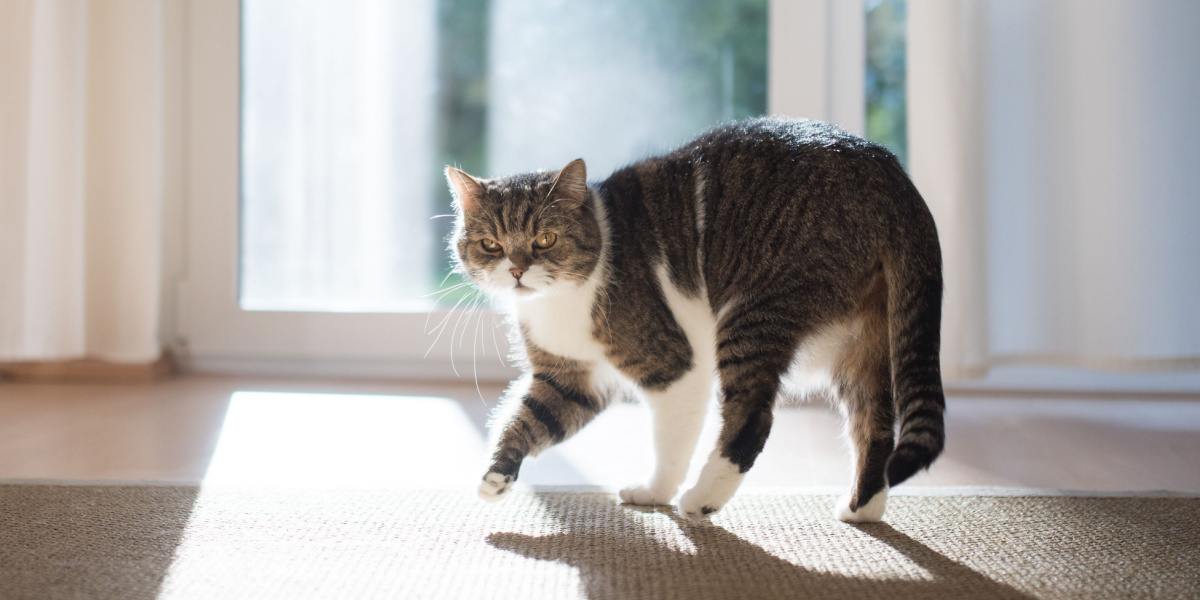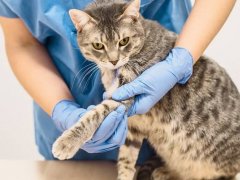
Like us, cats limp when it is too sore for them to use their leg normally. So, even if they seem completely normal in themselves, if your cat is limping then they are in pain and will probably need to see a veterinarian.
There are many reasons that your cat could be limping. Whether it is an emergency or something less serious, it is a good idea to know some cat first aid.
This in-depth article will help you understand the causes of limping in cats, what’s an emergency, and when you need to book a vet visit. It includes a step-by-step guide for examining your limping cat at home and first aid for common conditions.
Also Read: Cat Limping: Causes & When To Go To The Vet
When Is Limping in Cats an Emergency?

A cat who cannot use their leg at all or is in severe pain needs to see a veterinarian urgently.
As a cat owner, the most important thing you need to know about limping is when it is an emergency. If you notice your cat has suddenly started limping and is showing any of these other signs, then you must take them to your local veterinary practice immediately:
- Severe pain
- Dragging leg
- Leg hanging at an awkward angle
- ‘Crunching’ feeling when touching or moving the leg
- Bleeding that isn’t stopping
- Large or open wound
- Cold, limp leg or bluish paw pad
- Difficulty balancing
- Difficulty breathing
If you aren’t sure if your cat’s limping is an emergency, it is always better to ring your veterinarian to check. As vets, we would always rather you ring if you are worried about your cat, even if you think they might not need to be seen straight away.
Also Read: 10 Ways To Tell If Your Cat Is In Pain
When To See a Veterinarian
Most cats with a limp will need to be assessed by a veterinarian – either immediately or within 1-2 days if the limp is mild and they are otherwise normal. So, if you notice your cat is limping it is always a good idea to call your veterinarian.
However, it can be helpful to check your cat over first at home to see if you can work out why they are limping. This might allow you to provide important first aid before transporting them. Your findings will also help your veterinary clinic assess how urgently they need to see your cat.
Do not attempt to examine your cat if they are showing signs of an emergency or are reacting aggressively towards you. Instead, ring your local veterinary clinic immediately.
Also Read: 11 Signs That You Need to Get Your Cat To the Emergency Room
Examining the Limping Cat: A Step-By-Step Guide

A cat with a minor limp can be examined first at home, if safe to do so.
Important: This guide is not intended to replace a full examination by a veterinarian.
Ideally, you will need two people to examine a limping cat: one to hold the cat and the other to examine each leg. Remember, when cats are in pain, they are more likely to bite and scratch so only examine them if you think it is safe to do so. If your cat becomes sore or aggressive, stop and book a vet visit.
- Begin by calling your cat’s name softly and gently stroking them. If they become aggressive or painful, stop.
- Ask your helper to hold your cat gently from behind or from the side, with their arms wrapped around your cat’s body to hold them still.
- First, run your hand lightly down the length of the leg to check for obvious swellings, wounds, bleeding, or pain. If there are no obvious problems, you are ready to begin your detailed examination.
- Begin with the nails. Gently press on top of each toe to extend the nail– don’t forget the dew claws. Check for discomfort and ingrown, broken, or scuffed nails. Scuffed nails can be a sign of a road traffic collision.
- Check their pads and between the toes for wounds, swellings, or foreign bodies (eg. a thorn or piece of glass). Their paw pads should all feel warm to the touch.
- Next work your way up the rest of the leg. Feel for swelling, wounds, or signs of pain. Cats will usually pull the leg away or cry out if it is sore.
- You can then gently flex and extend each joint. They should move freely and smoothly. Check for stiffness, pain, and resistance.
- Repeat this exam with all four legs if you aren’t sure which leg is the lame one. Remember, you can compare what you find to the other leg to check if it is normal or not.
- Then run your hand gently along your cat’s back and neck to check for areas of discomfort.
- Finally, feel your cat’s pelvis. It should feel symmetrical on both sides, with no sore areas.
Also Read: How To Care For A Wounded Cat
Common Causes of Limping in Cats and How To Provide First Aid
Now you have examined your cat you might have an idea of what is causing their limp. But what can you do to help?
1. Emergency Causes of Limping in Cats

Some causes of limping in cats, such as broken bones, are emergencies and require urgent veterinary treatment.
As a cat owner, the most important things for you to know are the signs of an emergency, and when to take your cat to the veterinarian. Here are some explanations of some of the most serious causes of limping in cats, and what first aid you can provide at home before transporting them to your veterinarian.
All these conditions are emergencies. If you are worried your cat may be suffering from one of them, you should phone your closest veterinary practice immediately.
Broken Bones
Usually, a cat with a broken leg will not want to put any weight on it. You may also notice part of the leg is sticking out in a funny direction. They will usually be very painful. In some cases, you may also see other signs of trauma such as wounds or bleeding.
Broken bones are very painful. Do not try to examine your cat or apply a splint. Instead, try to keep them as still as possible. Control any bleeding by applying pressure with a clean dressing or fabric. Contain them in a cat carrier with soft bedding and transport them to your local veterinary practice.
Also Read: How Much Does A Cat X-Ray Cost?
Large Open Wound

Open wounds can lead to blood loss, infection and pain.
An open wound is one where the skin is broken. If the wound is large, you may see tissue or even bone. Open wounds need immediate care to prevent infection. If your cat has a large wound, they are likely to need surgery to repair it.
Large and open wounds are very painful. Do not try to clean the wound or bandage it unless you are unable to take your cat to a veterinarian quickly. If so, you should try to keep the wound clean. You can bathe the wound using sterile water (heat until boiling and then cool) to remove debris; however, this may be very painful. Keep your cat confined and transport them to a veterinary practice as soon as you are able.
Also Read: How To Clean A Cat Wound: Step By Step Guide
Severe Bleeding

Use a clean cloth and firm pressure to stop continuous bleeding.
Trauma is a common cause of lameness in cats and may cause bleeding. If your cat’s leg is bleeding and the flow of blood is not slowing down or stopping, you will need to provide emergency first aid.
To stop (or at least slow) bleeding, you will need to apply pressure to the wound. Use a clean towel to wrap around the leg and apply firm pressure to the site of the bleeding. If you can, try to raise the leg above the level of the heart. If the blood soaks through the towel you should use another over the top. Keep applying pressure whilst you transport your cat to your closest veterinary practice.
Also Read: Cat Blood Transfusions: Procedure, Cost, Success Rate, & Recovery
Thrombus
If you notice your cat dragging one or more of their back legs, they may be suffering from a feline aortic thromboembolism (FATE), also called a thrombus. This is a blood clot that gets lodged in a blood vessel, preventing the flow of blood to the leg. It can cause the limb to become limp and cold, with a bluish tinge to the pads. It is usually caused by an underlying heart condition.
A thrombus can be extremely painful, and cats often howl in pain.
You cannot provide first aid at home for a thrombus. You should take your cat to be examined by a veterinarian immediately.
Also Read: What To Do If You Accidentally Step On Your Cat
2. Less Serious Causes of Limping in Cats
Broken Nails
Broken or torn nails are a very common cause of lameness in cats. A broken nail is not serious, but it can be surprisingly painful.
If the break is near the toe or the nail is well attached, do not attempt to remove it yourself and book a visit to the veterinarian.
But if the break is towards the tip of the nail, or the nail is only very loosely attached, you can use nail clippers to remove the damaged part. Apply pressure using a clean towel or cloth for 5-15 minutes if there is any bleeding. You can also apply a silver nitrate stick or cauterizing powder (both are available from pet stores).
Once you’ve removed the broken nail and there is no bleeding, you can bathe the area in an antiseptic solution to prevent infection. Monitor the site for heat, swelling or discharge for a few days afterwards, as these can become infected.
Also Read: How Often To Trim Cat Nails: A Vet Explains
Foreign Bodies
A foreign body is anything that is not meant to be there. Common foreign bodies cats get in their legs or paws include thorns, glass, and grass seeds.
If you can see a large foreign body (such as a shard of glass) stuck in your cat’s leg or foot, you should not attempt to pull it out. Removing it could cause significant bleeding. Instead, take your cat to your veterinarian.
However, if it is small and it looks like it will come out easily (like a thorn), you can use tweezers to pull it out. Once it is removed, apply pressure with a clean cloth if there is any bleeding. Bathe the area in an antiseptic solution to prevent infection, and make an appointment to visit your veterinarian.
Also Read: What to Do When Your Cat Swallows a Foreign Object
Soft Tissue Strains/Sprains

Cats are active creatures and can get sprains and strains when they play, chase and jump.
Like us, soft tissue strains (also called a sprain) are common injuries in cats. Sprains usually cause mild limps in cats, and they will generally be happy in themselves otherwise. Some sprains can be treated with rest and confinement alone. But if the limp is not improving in 1-2 days you should book a vet visit. They may prescribe some anti-inflammatory pain relief medication or recommend an x-ray.
With mild soft tissue strains there is usually little to see or do. The best thing you can do at home is to help your cat rest the leg by confining them and trying to prevent them from jumping.
Also Read: Cat Back Legs Collapsing: Causes, Symptoms, & Treatment
Minor Wounds
A minor wound is one where the skin is not fully broken, like a graze, scratch or a superficial cut. You can manage these sorts of wounds at home by bathing them in boiled salt water or a dilute antiseptic solution. It can also help to apply an antibiotic ointment.
Also Read: How To Care For A Wounded Cat
If the wound shows any signs of worsening (becoming red, swollen, or discharging) then book an appointment with your veterinarian.
Abscesses
An abscess is a build up of pus, usually due to an infection. You may notice a small wound initially, that becomes suddenly swollen 1-2 days later. Often, cats with an abscess can feel unwell. You may notice that they are quiet or off their food.
If you suspect your cat has an abscess you should take them to your veterinarian who will lance the abscess, flush it, and possibly prescribe antibiotics.
If the abscess has already burst you can bathe the area in boiled salt water to encourage the abscess to drain and book a vet visit to have it checked.
Arthritis
So far, we have discussed the causes of sudden lameness. But by far the most common cause of lameness in cats is arthritis. Signs of arthritis in cats are subtle and include things like sleeping more, not jumping up as high, or being less playful than usual. By the time you notice your cat limping, the arthritis is often quite advanced.
If any of these signs sound familiar, book a visit to your veterinarian. There are lots of effective treatments for arthritis, from medications to environmental adjustments at home, and they can make a huge difference to your cat’s happiness as they grow older.
As arthritis is a chronic condition, there is no first aid advice. But if your cat is having a flare-up, and seems more sore than usual, it is sensible to restrict their exercise for a few days.
Also Read: What Can You Give A Cat For Pain? 6 Vet-Recommended Options
Some Final Words of Advice for Managing Your Limping Cat
As a vet, limping is one of the most common conditions I see. There are so many different causes of limping in cats – some serious, some less so.
Whatever the cause, these are my 3 golden rules when it comes to limping in cats:
- Know the signs of an emergency and keep the details of your local veterinary practice handy.
- Rest your cat as soon as they start limping. Whatever the cause of your cat’s limping, they are likely to need rest. Try to confine your cat to one room and prevent them from jumping.
- Do not give your cat human medication. When your cat is in pain, you want to help them feel better as soon as possible. But it is never worth the risk of giving them human medication, as many are toxic to cats. Your veterinarian will be able to provide pain relief that is safe for your cat.
Remember, if you are worried about your cat’s health, you should always ring your veterinarian for advice. That’s what we are here for.
Also Read: My Cat Is Not Grooming Themself: When To Worry
Frequently Asked Questions
How long should a cat limp before going to the vet?
If your cat is holding their paw up and will not walk on it at all, then this is a sign the leg could be broken, and you should go to your vet immediately. If the limp is mild and they are otherwise well in themselves, you can rest them at home and monitor. Book a vet appointment within 1-2 days if they are not improving.
Can a cat limp heal on its own?
Some limps will heal on their own with just rest. These include limps caused by mild sprains and small wounds. However, most causes of limping in cats require veterinary care.
How can you tell if a cat’s leg is broken or sprained?
A cat with a broken leg will usually not want to put their paw down at all. You might also notice the leg is at an awkward angle. If they are walking on the leg but with a mild limp it is more likely a sprain.
How do I treat my cat’s limping at home?
Some cases of limping can be treated at home with rest. But most cats will need to visit a vet if the limp is not improving within 1-2 days. Do not give human medication to your cat if they are limping.







